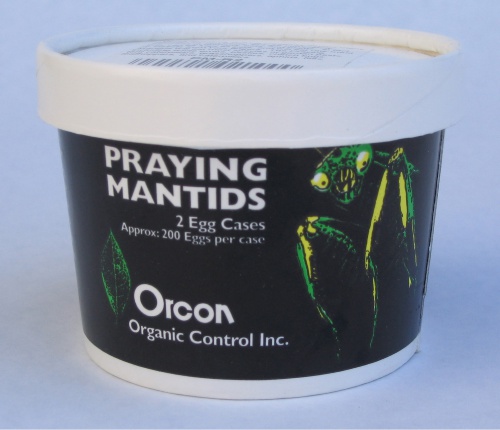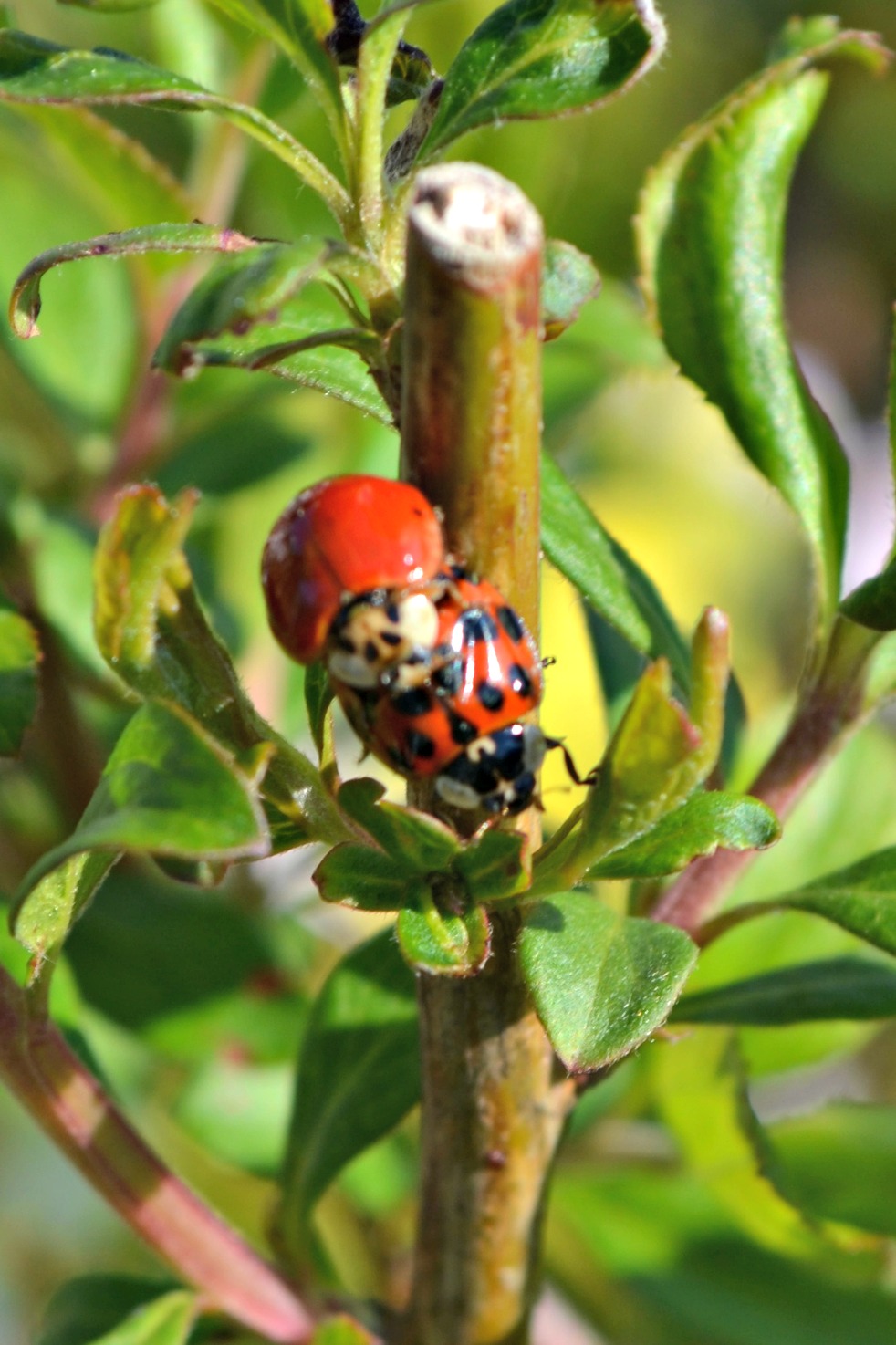Beneficial Critters
We receive a lot of help from our unseen friends in the landscape. Bees, ladybugs, praying mantids and spiders all lend a hand in controlling unwanted visitors in the garden, or help out in other ways. When insecticide sprays seem like too much, beneficial insects can help control insect infestations. Many helpful insects pollinate our vegetable gardens, fruiting plants and flowers.
I know many people who are terrified of bees, and rightly so because they are allergic to bee stings. It is important to understand that honeybees and bumblebees are generally not aggressive insects. They tend to stick to their work, buzzing from flower to flower collecting nectar to take back to their hive. In the process, bees do us the huge favor of pollinating our gardens. If you have planted a vegetable garden, blueberries, blackberries, or most any type of fruiting plants this year, remember to thank the bees and other pollinating insects for their hard work. Can you imagine how tedious it would be to try to pollinate each individual flower in your garden with a little brush? To attract bees to your garden throughout the season, plant plenty of annuals, perennials, trees, and shrubs that bloom in a wide range of colors throughout the year.
Spiders give me the creeps. I am not the type of person that jumps on a countertop and screams at the sight of an eight-legged, creepy-crawly critter, but I certainly do not play with them, either. The truth is, spiders can devour an enormous amount of insects in their lifetime. The downside to this is that spiders are not picky eaters. They will eat both harmful and beneficial insects. Regardless, I can appreciate something that is reducing the number of mosquitoes in my garden. Side note: Plants like Citronella (scented geranium), Lemongrass, Rosemary, Catnip and Lavender can help ward off mosquitoes.
Contrary to popular belief, there are only four species of poisonous spiders in the United States. The hobo, yellow sac, brown recluse, and black widow spiders are poisonous to humans. Of the four, only the brown recluse and black widow are common in North Carolina. These two are typically found in dark, cool, dry spaces. Wolf spiders are one of the most common spider species found in our area. If you are curious about how many spiders are in your garden, try this out: Go outside at night with a flashlight. Hold the flashlight up at your eye level and look around in the grass and in your garden (yes, your neighbor will think that you have finally lost it). Any reflective spots that you see will more than likely be wolf spiders. Trust me; you will see more than a few.
Praying mantids are, without a doubt, some of the coolest bugs around. The praying mantis is a green or brown carnivorous insect that can be up to six inches long. When at rest, the front legs of the mantids are folded under its head in a “praying” fashion. They wait, perfectly motionless, for their prey to come within reach, and then strike out with their strong front legs which are covered with overlapping spines. The mantis then devours its meal and starts the process over again. Mantids have a triangular shaped head which has a remarkable range of motion, much more than other insects. The females lay egg casings in the fall on stems of trees and shrubs. The casings are a little smaller than a table tennis ball and light brown in color. They young mantids hatch in the spring months and begin the life cycle all over again. If you have the opportunity to observe one of these insects in your garden, take time to do it. They are remarkable creatures.
Ladybugs are probably the most beneficial insect to have in our gardens. In both the juvenile and adult stages, ladybugs can devour thousands of garden pests. They predominately feed on aphids, which are common garden pests in North Carolina. Ladybugs are actually not bugs at all, they are beetles. They were originally imported from Australia to help control aphid infestations on citrus trees. Over four hundred species of ladybugs can be found in the U.S. today. We commonly get calls here at the garden center from people whose homes have been “infested” with ladybugs in the late winter months. These are Asian ladybugs that were imported to help control aphids on soybean crops. They tend to like the temperatures of our homes during the winter months. Ladybugs can be purchased in small containers and released in the garden to help control pest populations. It is best to wet an area in the garden and release the insects in the wet area when it is dark. The beetles are more prone to stay where they are released this way.
Do you have a pollinator friendly landscape? Whether you are just getting started in your yard or filling in a few gaps we all have an opportunity to promote a healthy environment for beneficial insects and pollinators. It’s best to choose a variety of plants that produce a continuous blooming cycle from spring to fall. Here are a few of our favorites plants that attract beneficial pollinators like bees, hummingbirds and butterflies:
Trees:
Golden Rain Tree, Koelreuteria paniculata
Southern Magnolia, Magnolia grandiflora
Cherries, Prunus sp.
Crepe Myrtles, Lagerstroemia indica
Redud Cercis sp.
River Birch Betula nigra
Fringe Tree Chionanthus
Tuplip Poplar
Service Berry
Shrubs:
Holly, Ilex sp.
Rose, Rosa sp.
Rose of Sharon, Hibiscus syriacus
Summersweet Clethra, Clethra alnifolia
Sweetspire, Itea virginica
Hydrangea, Hydrangea sp.
Chaste Tree, Vitex agnus-castus
Butterfly Bush, Buddleia davidii
Bottlebrush, Callistemon sp.
Spiraea, Spiraea sp.
Weigela
Azaleas
Jessamine
Perennials:
Yarrow, Achillea
Anise Hyssop, Agastache fueniculum
Bugleweed, Ajuga
Columbine, Aquilegia canadensis
Aster
False Indigo, Batisia
Bluebeard, Caryopteris
Purple Coneflower, Echinacea
Joe Pye Weed, Eupatorium
Blanket Flower, Gaillardia
Sunflower, Helianthus
Hosta
Lupine, Lupinus
Bee Balm, Monarda didyma
Catnip, Nepeta
Evening Primrose, Oenothera
Beard Tongue, Penstemon
Summer Phlox, Phlox paniculata
Gloriosa Daisy, Rudbeckia hirta
Mexican Sage, Salvia leucantha
Pincushion Flower, Scabiosa
Sedum, Sedum Autumn Joy
Goldenrod, Solidago
Lamb’s Ear, Stachys
Germander, Teucrium caradense
Mexican Sunflower, Tithonia rotundifolia spp.
Clover, Trifolium incarnatum
Ice plant, Delosperma cooperi
Annuals & Herbs:
Basil, Sweet, Ocimum basilicum
Lavender, Lavandula angustifolia
Rosemary, Rosemaryinus officinalis
Borage, Borago officinalis
Lemon balm, Melissa officinalis
Thyme, Common, Thymus vulgaris
Dill, Anethum graveolens
Winter savory, Satureja montana
Hyssop, Hyssopus officinalis
Peppermint, Mentha x piperita
Coriander (cilantro), Coriandrum sativum
Fennel, Foeniculum vulgare
Bee balm, Monarda didyma
Catnip, Nepta cataria
Catmint, Nepeta spp.
Sage, Salvia officinalis
Chives, Allium schoenoprasum
Sage, Pineapple, Salvia elegans
Geranium, Scented, Pelargonium spp.
Marjoram, Majorana hortensis
Lemongrass, Cymbopogon, Cosmos, Garden, Cosmos bipinnatus
Daisy, Gloriosa, Rudbeckia hirta
Gomphrena, Gomphrena haageana
Marigold, Tagetes erecta
Verbena, Verbena x hybrida
Lantana, Lantana trifoliata
Salvia, Salvia splendens
Sunflower, Helianthus annuus
These are just a few of our beneficial garden buddies & companion plants that help make a gardeners life easier. Remember that many insecticides will also kill these insects and some spiders as well. Be sure to read the label on all insecticides to help lessen the adverse affect of chemicals on beneficial insects.
Happy Gardening!
Brad Rollins & Nita H.
Fairview Greenhouses & Garden Center













